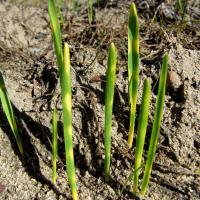Diagnosing deep seeding in cereals
When sown into a moist seedbed, shallower-sown seed will emerge sooner, with a more vigorous seedling.
What to look for
- Pale and weaker plants that are more frequent in softer soil areas or along seeding rows.
- Early sown crops are less affected than those sown in cold wet conditions.
Paddock
- Weaker less developed seedlings.
- Pale horizontal " football sock" stripes on seedling leaves.
- Very deep sown seedlings may fail to emerge.
- Seedlings are more susceptible to other stresses such as root disease, nematodes or water-logging.
Plant
What else could it be
| Condition | Similarities | Differences |
|---|---|---|
| Diagnosing allelopathy in cereals | Reduced plant emergence and weak seedlings | Silly seedling can occur with shallow sown plants with plants rarely recovering. |
Where does it occur?
- The importance of seeding depth to maximise crop potential is recognised by most growers. As a general rule, the shorter the coleoptile length of a cereal variety, the more accurate the seed placement needs to be.
- The coleoptile protects the first wheat or barley leaf as it pushes through to the soil surface.
Management strategies
- Choose long coleoptile varieties if seeding deep to access soil moisture.
Page last updated: Tuesday, 3 May 2016 - 8:44am



